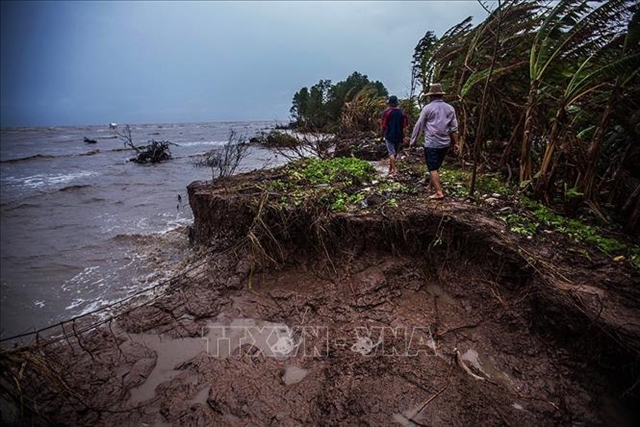 Society
Society


|
| Erosion along the coast in Cần Thơ Province has affected residential areas and caused damage to transport infrastructure. — VNA/VNS Photo |
CÀ MAU — The Ministry of Agriculture and Rural Development has begun inspections of erosion sites on riverbanks and coastal sites in Cà Mau Province.
Cà Mau is the first province in the Mekong River Delta to be inspected, which was ordered by the Prime Minister.
Nguyễn Xuân Cường, Minister of Agriculture and Rural Development, has directed the provincial authority to complete landslide prevention projects soon.
The province’s People Committee has petitioned the Government to allocate VNĐ947 billion for dyke projects that face a shortage of funds.
In addition, the provincial authority will continue to direct units to inspect landslide sites and identify potential landslide areas and promptly report to the Government, ministries and central branches.
The province’s west and east coasts are seriously affected by climate change. The East Sea coast has suffered strong erosion, between 30 and 50m every year, because dyke systems have not been able to prevent erosion.
Erosion has affected residential areas near the coast, causing damage to housing and transport infrastructure.
Meanwhile, HCM City has 37 eroded sites along rivers and canals, including 19 that have been classified as "very dangerous", according to the city’s Steering Committee for Incidents and Disaster Response, and Search and Rescue.
The rest of the sites, totalling nearly 23,500m in length, are classified as "dangerous". Many of them have been eroded for years.
They include the left bank of Phước Lộc Bridge; Cây Khô Canal; the right bank of an upstream section at the confluence of Kinh Lộ River and Tắc Mương Lớn Canal in Nhà Bè District; a section of Lòng Tàu River in Cần Giờ District; Xóm Củi Canal in Bình Chánh District; Tàu Hủ-Lò Gốm Canal in District 8; and others.
The city has 35 anti-erosion projects but construction process has been slow. Several investors failed to conduct surveys on terrain, geology and hydrography, and, as a result, they did not meet standards of technical safety, causing delays.
Parts of other construction projects have had to be repaired after completion, while others have faced compensation problems.
Erosion has been caused by illegal land exploitation at areas near the Sài Gòn River section in Củ Chi District and sections near Đồng Nai River, the rivers of Lòng Tàu and Soài Rạp, and Cần Giờ Sea.
A number of embankments built to protect river banks and canals have also been encroached upon, contributing to erosion.
The city People’s Committee in July told authorities in districts, wards, communes and towns to set up fences and warn residents not to travel in and near eroded sites.
Residents should move to other areas, it recommended. The city's Department of Construction should work with local people committees and provide accommodations to residents affected by erosion. – VNS




